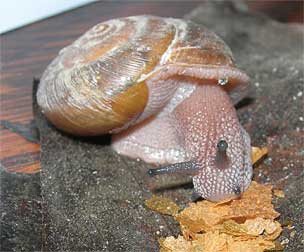|

|
The Section of Mollusks
By Meghan Holohan
 “Every snail is sacred,” Tim Pearce says, as he opens a drawer chock-full of them. “Every snail is sacred,” Tim Pearce says, as he opens a drawer chock-full of them.
Most people don’t think of snails unless they want them for dinner, but Pearce has devoted his career to them. Pearce is caretaker of the 1.8 million-piece mollusk collection at Carnegie Museum of Natural History, which also includes slugs, mussels, oysters, squid, and octopus, to name a few. A defining feature of the bunch is a radula—a long, spiky tongue that helps them grab food.
Because the expansive mollusk collection is primarily used for research, visitors are exposed to just a small sampling of what it has to offer, as is often the case with vast museum collections. So Pearce and his assistant, Paul Robb, decided to give museum visitors a peek at the dry shell collection—along with a few live slugs that Robb cares for as pets. And they’re admittedly surprised by the great response. Each session, held from 1-3 p.m. on Saturdays, draws a steady staple of 40 or so curious onlookers.
With the gentle, easy way he has about him, Pearce almost immediately folds visitors into
his world, first by showing off a handful of the flashier specimens in the collection, such as the many brightly colored shells and the pickled octopuses and squids, and then by making
unexpected real-world connections.
He opens the shell of a bland freshwater mussel, revealing mother of pearl on the inside, and then contemplates the question he’s frequently asked: Why is it important to study mollusks?
“A great deal of conservation work is based on museum collections,” he begins. “Through these dry specimens collected and preserved over centuries, we can tell what once was, and can infer what influences extinction.”
Pearce believes in conserving populations, even those that are slimy and gross. And the fact is, living mollusks serve a number of unique purposes. In addition to recycling nutrients, land snails and slugs are important food for other creatures, like chipmunks and fireflies, and are a crucial source of calcium for birds during egg-laying season. Freshwater mussels filter waste and impurities from rivers and lakes. And even though the non-native Zebra Mussels in Lake Erie cause serious ecological damage, Pearce suspects that their only redeeming quality, which still doesn’t come close to balancing their destruction, is that they help keep the once-polluted water clean. 
Snails, Pearce continues, play an important role in medicine, too. Holding a cream-colored shell with brown spots, he explains that these Pacific Ocean snails have stingers to paralyze prey. Researchers discovered that the poison in those stingers contains about 50 different peptides, and one of the peptides serves as a more potent painkiller than morphine. It’s also non-addictive and, unlike other opiate painkillers, people don’t build up a tolerance. There are six additional snail species in clinical trials for their painkiller properties and another for an anti-epilepsy drug.
Pearce’s love affair with snails started about the time most kids get a kick out of digging in the dirt, fascinated by the sticky snails and slugs they find there. Pearce just never stopped digging and never stopped being fascinated.
For six years and counting, he’s been building a census of Pennsylvania land snails. Before his study, it appeared that only a few species existed in the commonwealth. That is, until he realized that, previous to his own efforts, few people had been counting. Now, in every county he visits, he fills a large plastic food-storage bag with dirt and leaves, and when he returns to his laboratory, he filters the snails from the dirt. Today, he shows off a color-coded map indicating how many species and total number of snails he estimates exist in each part of the state.
Back in the shelves, Pearce opens a door and points to a large jar with a nearly foot-long snail with a brown shell and tan, slimy body tucked inside—the Giant African Snail. Illegal in the United States because it’s an invasive pest of agriculture and possibly plays a role in disease transmission, they’re kept as pets by people in Great Britain because they have “outgoing personalities”—meaning, they don’t mind being around humans.
Robb argues they are affectionate, but Pearce adds that only octopuses demonstrate enough intelligence for emotions—some octopuses play and respond to trainers. A friendly mollusk, however, will never nuzzle up to a human.
“A lot of our visitors don’t think about slugs having hearts,” Robb says, his fingers wrapped around one of the live pet snails, showing off a tiny, dark spot through the translucent shell—its pulsating heart.
“These lesser creatures of our world, we need them more than they need us.”
|
|
 Summer 2008
Summer 2008

 “Every snail is sacred,” Tim Pearce says, as he opens a drawer chock-full of them.
“Every snail is sacred,” Tim Pearce says, as he opens a drawer chock-full of them. 